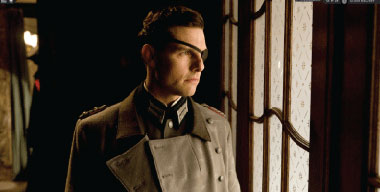 In July 1944, at the height of the Second World War, a daring band of German conspirators infiltrated Adolf Hitler's military headquarters and planted a bomb timed to go off during his daily conference. This was part of a wider plan, codenamed Operation Valkyrie, to take over the government and military from their Nazi overlords. The conspirators' aim was no less than the removal of the German dictator, followed by a negotiated peace with the Allies to bring the war to a close.
In July 1944, at the height of the Second World War, a daring band of German conspirators infiltrated Adolf Hitler's military headquarters and planted a bomb timed to go off during his daily conference. This was part of a wider plan, codenamed Operation Valkyrie, to take over the government and military from their Nazi overlords. The conspirators' aim was no less than the removal of the German dictator, followed by a negotiated peace with the Allies to bring the war to a close.
For that to be accomplished, Hitler and other top-ranking officials would have to be arrested or removed. The key was the assassination of Hitler himself. To that end, Colonel Claus von Stauffenberg courageously smuggled a briefcase full of explosives into German military headquarters in East Prussia, the so-called Wolf's Lair, and managed to plant it at Hitler's feet. At the last moment, however, the briefcase was shifted away from Hitler, so that when it blew up, he was spared the worst of the blast and survived the assassination attempt.
Emboldened by his survival, Hitler fought on and it would be almost another year before the Second World War finally ended in Europe and the Pacific.
That such a conspiracy came within an inch of success in spite of the heightened security and surveillance of Nazi Germany speaks volumes for the participants, who ranged from politicians and civic officials to military officers and church leaders. That it did not succeed spelled death to hundreds who were caught up in the Nazi snare of vengeance, including Stauffenberg, who was summarily executed within hours of the failed coup.
High Stakes
The noble but failed assassination attempt is now the subject of a large-scale Hollywood production, Valkyrie. Directed by Bryan Singer (The Usual Suspects, Superman Returns), Tom Cruise portrays Claus von Stauffenberg, the principal ringleader of the plot to kill Hitler. Grievously wounded in an air attack while serving with Rommel's famed Afrika Korps in 1943, he lost his left eye, right hand and the fourth and fifth fingers of his left hand. Posted back to Germany for convalescence, he was soon placed by the conspirators into a position where he could access Hitler. Says Tom Cruise, “Stauffenberg was someone who realized that he had to take the steps that ultimately cost him his life. He recognized what was at stake.” Cruise spent eight months preparing for the role, hiring a researcher, studying history books and speaking to members of the Stauffenberg family. Many parts of the film were filmed on location in Berlin.
The Courage to Act
Almost as soon as Hitler came to power in 1933, a coterie of disaffected German politicians and soldiers opposed the Nazi regime, but an important strand of the resistance always remained faith-based Protestants and Catholics. In fact, Christian outrage to Hitler's forced euthanasia program of mentally and physically challenged Germans was the only instance where the dictator backed down in the face of public opposition. Lutheran pastor Dietrich Bonhoeffer was a staunch critic of the Nazis and his fervent faith led him to see judgments of character and not action as fundamental to moral evaluation. “What is worse than doing evil,” Bonhoeffer noted, “is being evil.” Ultimately, every German had to rationalize what was happening. As the Hitler years dragged on, it took immense wellsprings of faith and courage for people like Bonhoeffer and Stauffenberg to act.
Not in Vain
Valkyrie poignantly illustrates how even during the darkest days of the Third Reich, German men and women of faith and conscience were willing to put their principles and beliefs to the test to oppose the evil pervading their country. That the resistance movement, uncoordinated as it was, ultimately failed to remove Hitler should not detract from their courage and their faith.









Leave a Comment